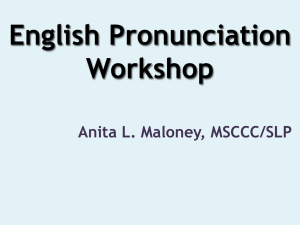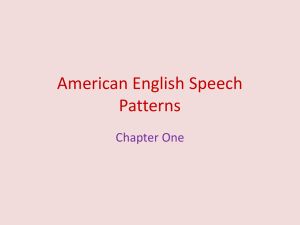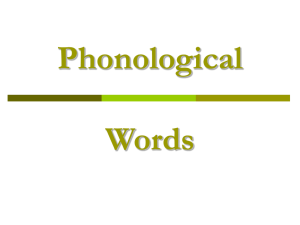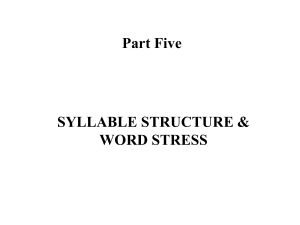LECTURE_13_Intonation_II
advertisement
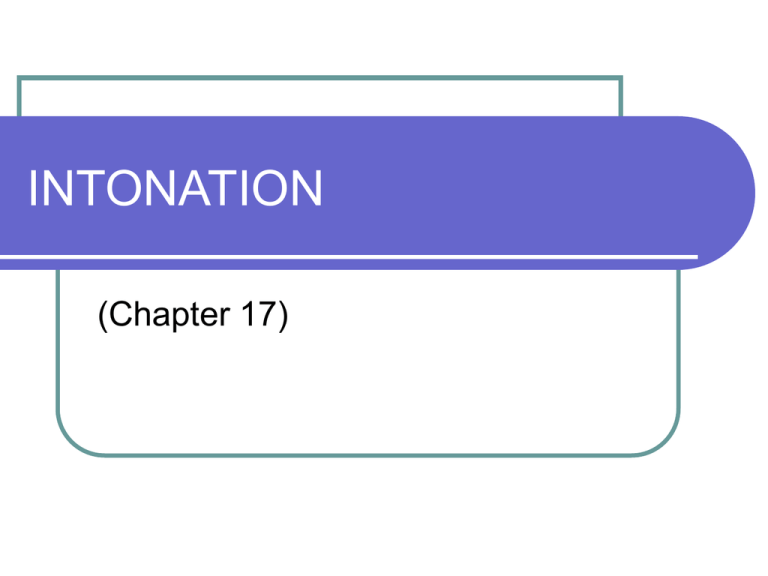
INTONATION (Chapter 17) Tone-unit When a tonic syllable is followed by a tail, the tail continues and completes the tone begun on the tonic syllable The easier case is that of rising and falling tones The more complicated one is that with the fall-rise and rise-fall Fall-rise and rise-fall + a tail Can be quite difficult to recognise when they are extended over tails since their characteristic pitch movements are often broken up or distorted by the structure of the syllables on which they occur The pitch movement on “some” If a syllable is added, the fall part of the fallrise is usually carried by the 1st syll. and the rise part by the 2nd: e.g. “some men” If the continuity of voicing is broken, i.e. if there are voiceless medial cons. to cause a break in the voicing ... E.g. “some chairs” The tonal rhyme is applied ... Just as “baloon” rhymes with “moon”, “ some chairs” has “tonal rhyme” with “ some” Tail of 2 or more syllables Normally the pitch is expected to fall on the tonic syllable and to remain low until the last stressed syllable in the tail. The pitch then rises from that point up to the end of the tone unit. If there is no stressed syllable in the tail, the rise happens on the final syllable (Roach, p.172) Rise-fall case If the tonic syllable is followed by a single syllable in the tail, the rise part of the tone takes place on the first (tonic) syllable and the fall part on the second (Roach, p. 173) High and low heads Head = all the part of a tone unit extending from the 1st stressed syllable up to, but not including the tonic syllable”. Pitch contrasts have been discussed so far only as possible choices of tone for the tonic syllable However, there are different pitch possibilities in the head as well. High head High head – the stressed syllable which begins the head is high in pitch; it is usually higher than the beginning pitch of the tone on the tonic syllable (Roach, p. 174) Low head Low head – the stressed syllable which begins the head is low in pitch; it is usually lower than the beginning pitch of the tone on the tonic syllable Unstressed syllables It is usual for these to continue the pitch of the stressed syllable that precedes them (Roach, p 174) When there is more than one stressed syllable in the head, there is usually a slight change in pitch from the level of one stressed syllable to that of the next, the change being in the direction of the beginning pitch of the tone of the tonic syllable When a high head is followed by a rise, the stressed syllables tend to move downwards towards the beginning pitch of the tone in the tonic syllable Declination The intonation pattern starting at a fairly high pitch, with a gradual dropping down of pitch during the utterance, is the most basic, normal, “unmarked” intonation pattern; this movement is often called “declination”. Marks and Used for two different purposes: to indicate stress, either primary or secondary In intonation: the mark indicates the stressed syllable in the high head and the mark indicates the stressed syllable in the low head A much more important difference is between the tonic stress and non-tonic stressed syllables Intonation is carried by the stressed syllables of a tone-unit and the pitch of unstressed syllables is either predictable from that of stressed syllables or is of so little importance that it is not marked at all. Problems in analysing the form of intonation 1) identifying the tonic syllable: it is the only syllable in the tone-unit that carries a movement in pitch BUT: a) When the tonic syllable is followed by a tail, the tone is carried by the tonic + tail together so that often no pitch movement can be detected on the tonic syllable itself b) c) One of the tones is the level tone so that in such cases the tonic syllable is identified only as the most prominent syllable. It sometimes seems as if some toneunits contain not one but two tonic syllables, the first having the a fall on it and the other having a rise (R., p.177) 2) Identifying tone-unit boundaries Grammar: utterances can contain one or more sentences; the boundary between them can be identified on grammatical grounds Suprasegmental phonology: Utterances may be divided into tone-units that can be identified on phonetic/phonological grounds It is possible to detect a sudden change in pitch level at the end of one tone-unit and the beginning of the following (speakers tend to “return home” to a particular pitch level to begin the new tone-unit) Rhythmical grounds: within the tone-unit speech has a regular rhythm which is broken or interrupted at the tone-unit boundary
